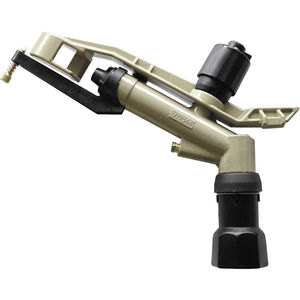
Impact sprinkler 86 Series
Add to favorites
Compare this product
fo_shop_gate_exact_title
Characteristics
- Type
- impact
- Reach
Min.: 13.5 m
(44'03" )Max.: 27 m
(88'06" )- Flow
Min.: 2,000 l/h
(528.34 us gal/h)Max.: 9,400 l/h
(2,483.22 us gal/h)
Description
VYR-86
AG FULL-CIRCLE SPRINKLER VYR 86 (PLAST. 1")
The VYR-86 is a circular agricultural sprinkler, made of plastic with 1" female connection, plastic or brass arm according to its reference, its axle and springs are made of stainless steel, and its o-rings and washers in stainless steel and special plastics to resist contact with the most aggressive fertilizers in the market.
This sprinkler is designed to work under flow rates between 2000 and 9400 L/H, at a nominal pressure between 2.75 and 6 BAR and with a range of coverage between 13.5 and 27 meters of diameter. The main nozzle has 26º of inclination with respect to the horizontal plane and the secondary one also has 26º degrees. Its average rotation time is approximately 25 sec./rot. (3 BAR, 4,40x2, 40mm).
For an optimum Coefficient of Uniformity (CU), our technicians recommend the use of this sprinkler with a spacing between heads and lines of 18x18 meters, up to 24x24 meters for rectangular frames, and from 18x20 meters to 24x30 meters for triangular frames.
The most common use given to this agricultural sprinkler is the irrigation of cereals, alfalfa, beet, leafy vegetables, legumes and tubers.
APPLICATIONS
Used in all types agricultural irrigation, generally with medium-high flow.
Horticultural plantations, cereals, tubers, leguminous plants and fruit trees.
Catalogs
No catalogs are available for this product.
See all of VYRSA S.A.‘s catalogsRelated Searches
- Hose
- Sprinkler
- Control valve
- Irrigation valve
- Irrigation filter
- Irrigation hose
- Plastic hose
- Plastic compression irrigation fitting
- Impact sprinkler
- Metal irrigation filter
- Plastic valve
- Screen irrigation filter
- Irrigation controller
- Hydraulic valve
- Straight compression irrigation fitting
- Threaded compression irrigation fitting
- Electric valve
- Threaded valve
- Stainless steel irrigation filter
- Digital irrigation controller
*Prices are pre-tax. They exclude delivery charges and customs duties and do not include additional charges for installation or activation options. Prices are indicative only and may vary by country, with changes to the cost of raw materials and exchange rates.










